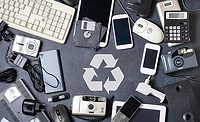Advancing Adhesives
Adhesives and Sealants' Role in Electronics Device Design
Mobile electronics device design trends are driving adhesive innovation.

Design is all about tradeoffs. Mobile device manufacturers have to balance everything from cost and aesthetics to performance and durability―and then design a product that can both survive and thrive in today’s competitive consumer markets.
The demand for consumer electronics is higher than ever before. There are almost as many cell-phone subscriptions (6.8 billion) as there are people on this earth (7 billion). Research shows that people spend an average of 8 hrs, 21 min sleeping a day—but spend an average of 8 hrs, 41 min on media devices. Even more interesting is the finding that the majority (81%) of smartphone users have their phones switched on all the time, even in bed.
Virtually every aspect of the finished device is critical to its success, making the design process a high-stakes game of multidimensional chess. As devices become ever more complex, the connections that join a handful of components into finished products can have a huge impact on the speed, cost and efficiency of their manufacturing processes, as well as the quality and performance of the end products. The ways in which those connections are made are a key aspect of the product’s design, and more and more of those connections are made using adhesives.
What’s more, the critical factors aren’t just those inherent in the end-product itself. They also include aspects of manufacturability: the materials and processes used to turn the design into an attractive, durable, functional, affordable physical product you can take to market.
Durable Bonds that Last
A walk down the adhesives aisle of any hardware store suggests just how complex the choices can be. There are general-purpose adhesives, as well as specific products for wood, plastic, metal, paper, and fabric. The adhesives for plastic alone can be very resin-specific and take up yards of shelf space. There are one-part and two-part products, and there are adhesive solutions that reach working strength in a wide range of time―from mere seconds to several hours. They can be applied by consumers from tubes, cans, syringes or guns. Manufacturers have even more choices, which, when played out over tens or hundreds of thousands of uses, are more critical to the cost and quality of finished goods than anything a consumer is likely to use.
The trend of using fewer screws, bolts and rivets in mobile communications devices continues to grow. Manufacturers are instead leaning on high-tech industrial adhesives providers to ensure product performance and appearance. The performance of those adhesives is measured several ways.
“While mobile electronics devices tend to have a relatively short product life, the adhesive that holds it together will have to stand up to environmental extremes—from extreme heat or cold to exposure to any number of chemicals,” says Matt Perry, director of global electronics for H.B. Fuller. “Few electronic devices are likely to get dipped in gasoline or acetone, but they may be exposed to perfumes, sunscreen, bug repellent, sweat, and more. Devices have to stand up to extremes of temperature, not just the heat of a summer day, but the extreme heat of a car left out in the sun on a summer day. The same is true for the extreme cold of a night out in the car in mid-winter, the UV exposure of a day at the beach, or the humidity of a muggy day in July.”
In cycles―hot and cold, humid and dry―some adhesives simply wear down. Take, for example, the glass touchscreen of a cellphone. By design, the touchscreen itself is resilient enough to handle the rough-and-tumble of carrying, handling and occasional mishandling to which it will be subjected. The connection of the screen to the body of the phone has to be just as tough.
Bond strength varies from adhesive to adhesive, but an individual adhesive’s bond strength varies depending on the substrates to which it is bonding. Since many bonds are made between unlike materials, it is important to know how well the adhesive works with both. Wet out, or the degree to which an adhesive flows and covers a surface and maximizes the contact area and the adhesion to the bonding surface, determines bond strength. Technically, effective wet out occurs when the surface energy of the adhesive is as low as or lower than the surface energy of the substrate. This is why an adhesive’s bond strength varies depending on the substrate. For example, the bond strength of a particular adhesive, measured in MPa (MegaPascals or million newtons per square meter), can be over twice as high with polycarbonate as with glass.
The Right Adhesive for the Job
To deliver lighter, thinner, stronger mobile electronics devices with ever greater processing power, manufacturers need to utilize non-traditional materials in the construction of their products. As screens get larger and move closer to the edges of the device face, for example, the adhesive used to adhere the screen to the phone body has to be laid down in a thinner, more precise line. This affects aspects of the adhesive itself, such as viscosity, along with the type of application equipment used.
Reactive hot-melt adhesives* can withstand heat better than many thermoplastics. Many consumers are familiar with hot-melt glue guns. While they don’t provide the strongest of bonds, they do provide a quick, clean bond and are easy to use. Consumers are also probably familiar with the one-part, moisture-activated glues that take longer to cure but provide the superior strength usually alluded to in their product names. Reactive hot-melt adhesives are hybrids that combine the best of both adhesive types in a single product. They have a short open time as they cool, deliver good immediate green strength, and provide superior bond strength once fully cured. Specialized equipment for application can help provide clean, accurate application, eliminate stringing and mess, and provide the necessary heat for application without overheating the adhesive reservoir and potentially destabilizing the material. Essentially, these adhesives combine the characteristics of a thermoplastic, which softens with heat and re-solidifies when cooled, and a thermoset, which cures to form a creep-resistant, crosslinked matrix that does not soften with heat.
Conversely, adhesive films are easier to store and handle than adhesives in liquid or gel form, and they are available in a variety of forms. These solutions** stay right where you put them and require little or no cleanup. Electronics device manufacturing is a field in which neatness counts. A drop of spilled liquid adhesive could turn a mobile device into scrap, at worst, or require costly re-work at best. Film adhesives require less equipment and training to use, which provides production flexibility. And, unlike some other adhesive technologies, films can support faster production processes. The potential for increased throughput helps control costs and speed products to market.
These are just two examples of how this fast-moving, innovative market consistently demands better and more sophisticated adhesive technologies to help deliver existing and next-generation devices and related accessories. As the market continues to shift and evolve, adhesive innovators can help make devices we haven’t yet dreamed of. ASI
*such as H.B. Fuller’s Cyberbond and TONSAN solutions
**H.B. Fuller’s Flexel™ reactive film adhesive
For more information, visit www.hbfuller.com.
Looking for a reprint of this article?
From high-res PDFs to custom plaques, order your copy today!





